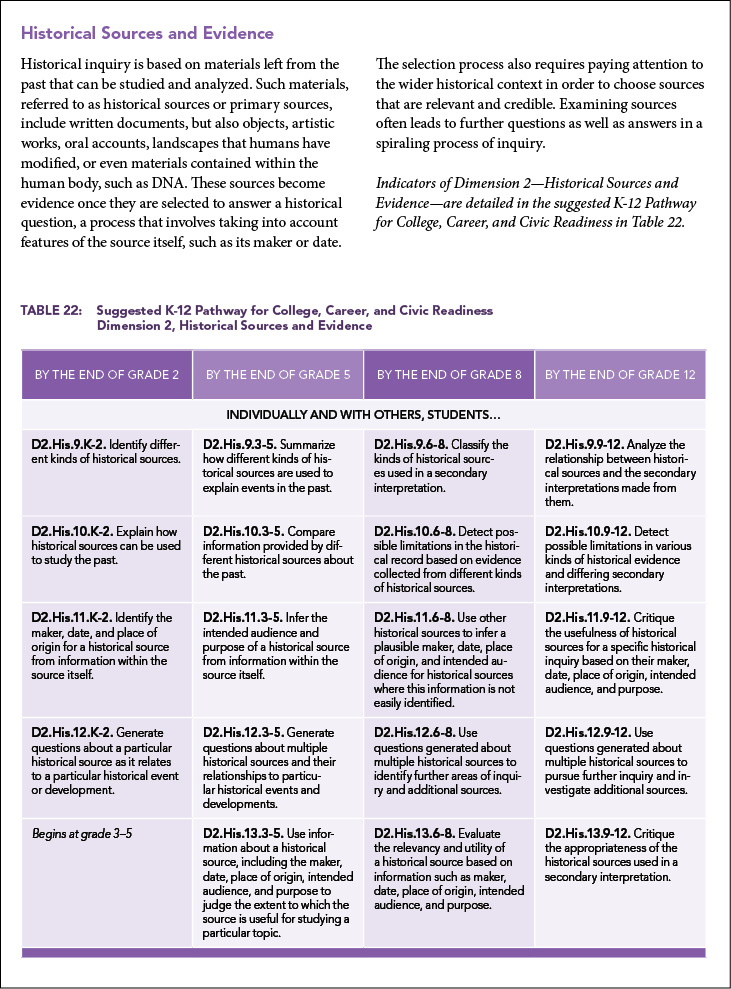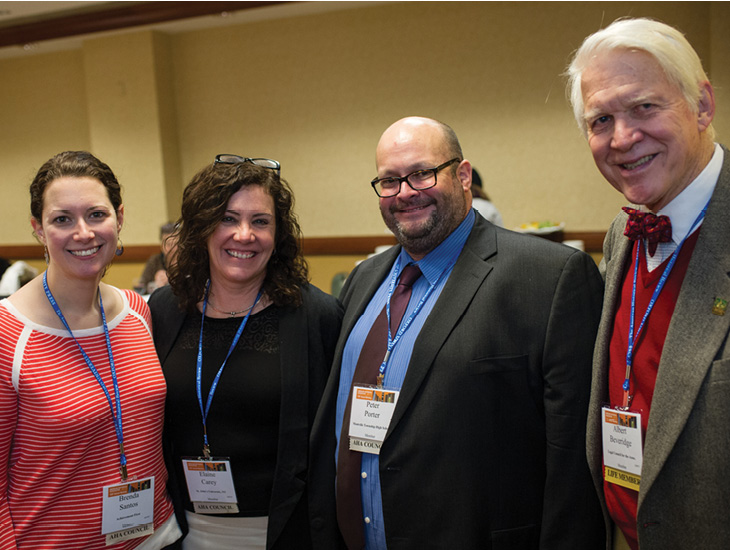From the Vice Presidents
The C3 Framework: Advocating for K-12 Social Studies Education
The shape of K–12 history education in the United States is undergoing a change. The AHA is committed to advocating on behalf of the historical profession in this continuing conversation, both in its work within the organization and by partnering with other historical organizations. The conversation within and outside the AHA has shifted from K–12 to K–16; it is now about comprehensive history education from kindergarten through undergraduate studies. That conversation has gained momentum with the AHA’s collaboration with the National Council for the Social Studies (NCSS) to develop the College, Career, and Civic Life (C3) Framework for Social Studies State Standards.1 For three years, social studies experts, curriculum specialists, K–12 teachers, and scholars from the areas of economics, geography, history, and the humanities reenvisioned the purpose of these fields and the best K–12 instructional practices.2 The C3 framework is a rigorous document for students, their parents, teachers, and college professors.
In working with the NCSS to develop this framework, the AHA has argued on behalf of history as part of social studies education. The field of social studies connects education to democracy in order to foster engaged citizens. It allows for students to study diverse perspectives that are important to living, learning, and working in a globalized world and a changing nation. Furthermore, social studies nurtures critical thinking and inquiry-based education by building and integrating knowledge of content with conceptual understanding. The study of civics, economics, history, and geography immerses students in the investigation and study of enduring questions and themes.

A page from the College, Career & Civic Life (C3) Framework for Social Studies State Standards.
The concepts in the C3 framework are gaining traction in large and small public school systems. This impact was evident at two conferences I attended in November, the first in New York City, which had a more local approach, and the second at the NCSS national conference in Boston, which demonstrated the growing national changes. On election day, November 4, 2014, over one hundred social studies teachers gathered at the Alexander Hamilton US Customs House in lower Manhattan for an all-day professional development conference. Navigating the Newness: Improving Content, Pedagogy, and Professionalism was jointly hosted by the Association of Teachers of Social Studies/United Federation of Teachers, the National Archives at New York City, the Council for Economic Education, and the Smithsonian National Museum of the American Indian.
The conference showcased the changes in social science education in New York City. Eric Contreras, newly appointed NYC Department of Education’s executive director of social studies education, introduced a social studies initiative that included a focus on curriculum and instruction; professional development and learning; and partnerships and collaborations. The post now held by Contreras had been vacant for nine years.
To the teachers gathered, Contreras and Christopher Zarr, an education specialist at the National Archives at New York City, asserted that social studies matters for the development of an engaged citizenry, and they argued for the centrality of history and historical thinking skills. In breakout sessions, teachers, archivists, and public historians interpreted the disciplinary concepts of the C3 to offer educators models and materials to teach such topics as American Indian removal, the civil rights movement, US foreign policy, and the US Constitution.
The ongoing involvement of AHA members Flannery Burke, Merry Wiesner Hanks, and Bruce VanSledright and other historians in crafting the C3 meshes with advocacy work the AHA engaged in last year. At the start of the school year, the AHA wrote a letter in support of students in Jefferson County protesting curriculum changes in AP history that might lead to a reductionist version of US history. A few months later, the AHA submitted a letter to the Department of Education in the state of California advocating for multi-vocal, inclusive history education, fulfilling the spirit of the FAIR Act, which was up for revision. In New York State where the social studies teacher conference Navigating the Newness was held, the AHA also submitted a letter to the New York Board of Regents arguing against reducing the number of history subjects required for the New York Regents Diploma.

Credit: Marc Monaghan
From left to right: Councilors Brenda Santos and Elaine Carey, former councilor Peter Porter, and AHA life member and counsel Albert Beveridge.
At the NCSS national conference, teachers, professors, administrators, and representatives from civics, geography, history, and economics presented different interpretations and applications of the C3 framework. The conference opened with the College and University Faculty Assembly meeting in which panels addressed K–16 social science education. The following days focused on an array of methodologies, applications, and interpretations of the C3 framework such as reports on practical experiences using it and engaging students, and proposals for revising state standards using the framework, just to name a few approaches.
In the fall, I circulated the summarized history disciplinary concepts and tools contained in the C3 framework to my colleagues.3 They were surprised and pleased by the breadth of historical thinking and the inquiry arc that our colleagues expected of elementary to high school students. The emphasis on change, continuity, context, diverse perspectives, evidence, and causation are not new to many of us. But what will change in university and college classrooms if a large number of students readily demonstrate these skills? One colleague mentioned to me that this meant we, college professors, would have to change how we approach and teach history. I welcome that future challenge.
Elaine Carey is vice president of the Teaching Division and chair of the history department at St. John’s University in Queens, New York.
Notes
1. National Council for the Social Studies, College, Career & Civic Life (C3) Framework for Social Studies State Standards: Guidance for Enhancing the Rigor of K–12 Civics, Economics, Geography, and History,
www.socialstudies.org/system/files/c3/C3-Framework-for-Social-Studies.pdf.
2. Michelle Herczog, “The College, Career, and Civic Life (C3) Framework for Social Studies State Standards: A Watershed Moment for Social Studies,” in Social Studies for the Next Generation: Purposes, Practices, and Implications of the College, Career, and Civic Life (C3) Framework for Social Studies State Standards (Silver Spring, MD: National Council for the Social Studies, 2013), 1.
3. National Council for the Social Studies, “Social Studies for the Next Generation: Purposes, Practices, and Implications of the College, Career, and Civic Life (C3) Framework for Social Studies State Standards,” NCSS Bulletin 113 (2013): 45–49.

This work is licensed under a Creative Commons Attribution-NonCommercial-NoDerivatives 4.0 International License. Attribution must provide author name, article title, Perspectives on History, date of publication, and a link to this page. This license applies only to the article, not to text or images used here by permission.
The American Historical Association welcomes comments in the discussion area below, at AHA Communities, and in letters to the editor. Please read our commenting and letters policy before submitting.
Tags:
Comment
Please read our commenting and letters policy before submitting.






